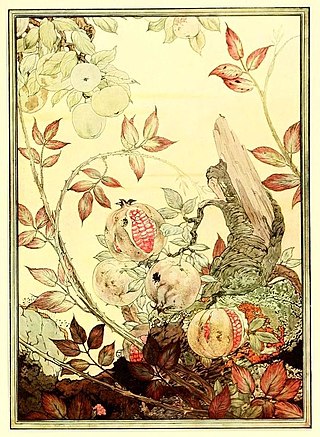
Aesop's Fables, or the Aesopica, is a collection of fables credited to Aesop, a slave and storyteller who lived in ancient Greece between 620 and 564 BCE. Of varied and unclear origins, the stories associated with his name have descended to modern times through a number of sources and continue to be reinterpreted in different verbal registers and in popular as well as artistic media.

The Frog and the Ox appears among Aesop's Fables and is numbered 376 in the Perry Index. The story concerns a frog that tries to inflate itself to the size of an ox, but bursts in the attempt. It has usually been applied to socio-economic relations.
The Deer without a Heart is an ancient fable, attributed to Aesop in Europe and numbered 336 in the Perry Index. It involves a deer who was twice persuaded by a wily fox to visit the ailing lion. After the lion had killed it, the fox stole and ate the deer's heart. When asked where it is, the fox reasoned that an animal so foolish as to visit a lion in his den cannot have had one, an argument that reflects the ancient belief that the heart was the seat of thoughts and intellect. The story is catalogued as type 52 in the Aarne-Thompson classification system.

Aesop is an almost certainly legendary Greek fabulist and storyteller, said to have lived c. 620–564 BCE, and credited with a number of fables now collectively known as Aesop's Fables. Although his existence remains unclear and no writings by him survive, numerous tales credited to him were gathered across the centuries and in many languages in a storytelling tradition that continues to this day. Many of the tales associated with him are characterized by anthropomorphic animal characters.
The Perry Index is a widely used index of "Aesop's Fables" or "Aesopica", the fables credited to Aesop, the storyteller who lived in ancient Greece between 620 and 560 BC. The index was created by Ben Edwin Perry, a professor of classics at the University of Illinois Urbana-Champaign.

The Fox and the Lion is one of Aesop's Fables and represents a comedy of manners. It is number 10 in the Perry Index.

The Trees and the Bramble is a composite title which covers a number of fables of similar tendency, ultimately deriving from a Western Asian literary tradition of debate poems between two contenders. Other related plant fables include The Oak and the Reed and The Fir and the Bramble.

The Horse and the Donkey is one of a number of ancient animal fables that illustrate the importance of helping others and the consequences of neglecting that duty.

The Dog and the Wolf is one of Aesop's Fables, numbered 346 in the Perry Index. It has been popular since antiquity as an object lesson of how freedom should not be exchanged for comfort or financial gain. An alternative fable with the same moral concerning different animals is less well known.

The Fox and the Weasel is a title used to cover a complex of fables in which a number of other animals figure in a story with the same basic situation involving the unfortunate effects of greed. Of Greek origin, it is counted as one of Aesop's Fables and is numbered 24 in the Perry Index.
The Fox and the Woodman is a cautionary story against hypocrisy included among Aesop's Fables and is numbered 22 in the Perry Index. Although the same basic plot recurs, different versions have included a variety of participants.

The Ass and his Masters is a fable that has also gone by the alternative titles The ass and the gardener and Jupiter and the ass. Included among Aesop's Fables, it is numbered 179 in the Perry Index.

The Old Man and the Ass began as a fable with a political theme. Appearing among Aesop's Fables, it is numbered 476 in the Perry Index.

The Old Woman and the Wine Jar is one of Aesop's Fables and is numbered 493 in the Perry Index. It has been applied to situations where an influence for good is lasting, such as the effect of education.
There are no less than six fables concerning an impertinent insect, which is taken in general to refer to the kind of interfering person who makes himself out falsely to share in the enterprise of others or to be of greater importance than he is in reality. Some of these stories are included among Aesop's Fables, while others are of later origin, and from them have been derived idioms in several languages.

The Eagle and the Fox is a fable of friendship betrayed and avenged. Counted as one of Aesop's Fables, it is numbered 1 in the Perry Index. The central situation concerns an eagle that seizes a fox's cubs and bears them off to feed its young. There are then alternative endings to the story, in one of which the fox exacts restitution, while in the other it gains retribution for its injury.

"The Lion Grown Old" is counted among Aesop's Fables and is numbered 481 in the Perry Index. It is used in illustration of the insults given those who have fallen from power and has a similar moral to the fable of The dogs and the lion's skin. Parallel proverbs of similar meaning were later associated with it.
The fable of The Fox, the Flies and the Hedgehog is ascribed to Aesop’s Fables. From its beginning it was applied satirically to political leaders and is numbered 427 in the Perry Index.

The story of the bald man and the fly is found in the earliest collection of Aesop's Fables and is numbered 525 in the Perry Index. Although it deals with the theme of just punishment, some later interpreters have used it as a counsel of restraint.














